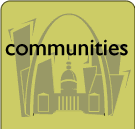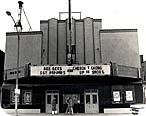| home | our mission | contact us | issue archive |

Mar 2001 / communities :: email this story to a friend

Grand Human Being
By W.F. GunnIt takes the Mississippi river about twelve minutes to move fifteen million gallons of water from Grand Boulevard's northernmost starting point in St. Louis, to the great street's terminus nine miles south. The street and the river scribe parallel flow routes across the city: one moves liquid, the other a human flow. At their farthest point of separation there is a mere three miles between the underbelly of Grand Boulevard on the west, and the great river on the east. Although some aberrant street signs, and nearly all dependent denizens, call it Grand Avenue, or simply Grand, it is, according to official Missouri records, AAA Auto Club maps, and other municipal means identified as Grand Boulevard.
St. Louis lies for the most part between the Arctic Circle and the Tropic of Cancer. Once an ocean floated above it followed by glaciers, then cycles of forests and prairies and evolving species. Up high, thousands of feet in the air and many miles away, in a glittering profile of rivers, St. Louis thrusts out like a figurehead from the great Ozark Plateau into the Mississippi Valley.
Thousands of years BC after the glaciers, the river's path already ancient, there came the humans. Osage, Shawnee and Cherokee nations followed an animal trail that burrowed through vast rolling oak forests, dipped down into the Mill Creek Valley, forded the River Des Peres, and went for miles across prairie and long hills crowded with creeks and creatures. In most recent centuries the Spanish and the French and frontiersman and settlers who became Americans turned the trail into a path that became a road that became a street that became Grand Boulevard. In their successive wakes they have built lodges and farms and skyscrapers for places to live and work. They built them out of grasses and lumber and skins, brick and asphalt, concrete and steel, structures that lasted from generation to generation, not unlike the Hammercop.
Ornithologists consider the South African Hammercop, or "lightening bird," to be the king of all birds. It is a unique generational nest builder. The Hammercop will labor from first flight, and on throughout its adult life, to build a monumental nest which it then abandons after its one and only use of it. For many, many years afterward, however, nearly 100 species of different birds will use the giant Hammercop's structure for hatching their own young.
So it is with those who build cities that aspire to longevity and a sense of common space. Humans, unlike the Hammercop, allow ego to urge legacies of both physical and moral structures, often bending them to the moment and more seriously to affect what is to come.
The Ritz - circa 1975
by Adina Diaz
click to enlargeIn the great sweep of history, no matter who owns what when, who tears down or who builds, the procession of Grand Boulevard's lightening birds will continue along its great lateral expanse. One after the other the buildings along Grand Boulevard will continue to serve merchants, research hospitals, a children's hospital, private clubs, a university, a half a dozen high schools and grade schools, movie houses and dance halls, restaurants, funeral homes and parks and grocery stores. Dozens of the city's largest and most diverse churches are nestled in and among a range of living accommodations, from shacks to luxury apartments to rooms above store fronts to sprawling mansions. Some of these nests change purposes; what was once a bakery becomes a pawn shop, a parking lot, then blooms into something else. Some changes are apocryphal, like concrete highways that lie over large swaths of the city, and then there are those places that have been drained of life force and lie fallow, abandoned till better times. But these are just Grand Boulevard's stages and canvases, the substrates of human existence.
The human stories of Grand Boulevard's past and present are stories of its societies, of history, of commerce, of memory, of humans being. In just the last few centuries there have literally been millions of our species who have lingered along Grand Boulevard to pursue individual versions of human being. Among the vast legions of us that have come and gone perhaps the most poetic was the Osage culture. The Osage lived for centuries on the same ground that would become Grand Boulevard. They built their lodge pole longhouses covered with hemp mats and skins and arranged them irregularly about a common space; a ceremonial place used for dancing and council meetings and tribal ceremonies. Osage tribal life centered on that common space in which clans of symbolic sky and earth groups, with the latter further subdivided to represent dry land and water would engage the universe and all that it contains.
In this, my fiftieth year of life, I have come to recognize the wisdom of the Osage, and in particular, I find inspiration in one of their more poignant ceremonies: shortly after birth, children were brought to the common space and presented to tribe. One after another, every member of the tribe would hold the baby and tell it a truth about the universe. This trusting visceral connection to each member of the tribe is no different in its way from our own experience passing through family and then out in the world among others. It is the stories of truth told in the common space that give meaning to the universe of Grand human being.
W. F. Gunn is a sculptor and writer and 35-year resident of Grand South Grand. His career in things creative include ten years in the visual arts as owner of a design and gallery business (Arsenal at Michigan) and as publisher of an art magazine (Ars Actus). After ten years in the performing arts as founder of the Sheldon Arts Foundation, he is now pursuing a dual career in the literary arts and public art design.
Church and State | Games | Expatriates | Communities | From the Source
It's All Happening | Young Minds | The Ordinary Eye | Elsewhere
Sights and Sounds | Media Shoegaze | A Day's Work | From the Editor
© 2001 The Commonspace

